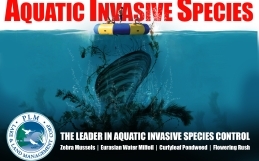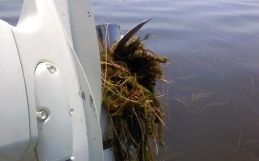Minnesota Curly Leaf Treatment: On the morning of Monday, May 16th contractors from PLM Lake and Land Management Corp. set out to treat Lake Benton with an experimental mix of chemicals it is hoped will help control an invasive plant species…
Choking lakes, commerce
May 17, 2011
On Monday morning contractors from PLM Lake and Land Management Corp. set out to treat Lake Benton with an experimental mix of chemicals it is hoped will help control an invasive plant species.
Curly-leaf pondweed originated in Europe and more than likely entered the northern U.S. through the St. Lawrence Seaway in the water ballast of ships.
“Lake St. Clair is the first stop for invasives,” said Mark Heilman, aquatics technology leader at Sepro Corp., which will be monitoring chemical concentrations in the troubled lake for the next several days.
The weed is thought to have invaded Lake Benton sometime in the 1970s, according to Heilman. It is not known how it got to the lake, but once there it flourished until it replaced native species.
“This lake is renown for not having any native plants,” Heilman said.
Lincoln County Environmental Administrator Robert Olsen said for years the weed problem got worse and worse. In 2004 it bloomed in an immense canopy that covered the surface of the lake, making it useless for recreation, threatening the economy of the town, and adversely affecting the tax base of Lincoln County.
“In 2004 I stood on the dock and saw a 10 to 12 pound carp jump out of the water and stick on the bed,” Olsen said. “It was so thick a 30-mile per hour wind would not create a wave. The lake association had fishing tournaments until 2004 when seven or eight boat engines ingested the weed and were damaged.”
The weed grows under the ice during winter, Olsen said. In spring it blooms from around Memorial Day to the Fourth of July, forming a dense canopy that covers the surface of the lake, then dies off. When it dies, some sinks to the bottom where the decaying biomass promotes algae blooms potentially harmful to fish. Worse, some drifts ashore with trapped fish and crustaceans to form unsightly stinking heaps.
“The smell was atrocious if it was warm out,” said Heather Ulrich-Glynn, community executive director for the town of Lake Benton. “It’s not something you wanted to swim in.”
Ulrich-Glynn said the local economy was seriously damaged as word got out Lake Benton was not a place you wanted to go to.
Renee Becker bought and renovated a resort along the lake shore six years ago, taking the risk that something could be done about the lake.
“That’s when they were just starting to treat,” Becker said. “There were piles of it along the shore. It was pretty nasty. When we went to trade shows in Sioux Falls, St. Cloud and Nebraska, people would ask, ‘Have they cleaned up the lake yet?'”
Prior to 2002 the Lake Benton Lake Association used mechanical harvesters until the weed mat became too thick, then turned to chemical means of control from 2005-2009, according to Olsen. The county did not treat the lake in 2010, due to funding restrictions.
“We had the idea to muster our resources in 2010,” Olsen said. “We hoped we could bring it into a range where we could go without treating for a while. But we’re walking in the dark, we’ve got no sound data to judge.”
Olsen said the county is using a practice not used anywhere else, trying to control the weed with a lower-than-recommended concentration of the herbicides, hoping to control both the weed and the cost of keeping it under control.
“The goal is to keep the curly leaf from reproducing, growing up and achieving surface,” Olsen said.
Patrick Selter works for PLM applying the herbicides to the lake. He said this year they are using the herbicide Sonar AS, which they have used on the lake since they started chemical treatment. This year they will also use a new herbicide, Clear Cast, on 35 acres of the lake to see how it works.
“We provided Southwest Minnesota State University with data and costs for an economic impact, feasibility study,” Selter said. “The Army Corps of Engineers did lab tests to determine best rate of use.”
Selter said the concentration of herbicides in the lake after treatment will amount to a few parts per billion.
“To give you an idea,” Selter said, “put two bottle caps along the equator. That’s a part per billion.”
Selter said there will be no restrictions on fishing or swimming in the lake due to treatment.
Cost of lake treatment is high, about $60,000 for this year, according to Selter.
“At one point it was $150,000,” Selter said, “so it’s coming down.”
According to Olson, managing the weed, which is found in about 1,000 Minnesota lakes, is always a trade-off between cost and the benefits to the economy and the tax base.
“On the county side we always look at tax capacity,” Olsen said. “Property valuations round the lake increased 2 to 3 percent per year. After treatment they’ve increased 25 to 30 percent.”
According to figures supplied by the Minnesota Department of Revenue, tax receipts in Lincoln County hit a low of $110,000 for accommodation, and $3,492,000 for food service and drinking places, in 2004 when the weed bloom covered the lake. From 2004, tax receipts for Lincoln County went up every year, reaching a high of $4,008,000 for food service and drinking places in 2006, and $310,00 for accommodation in 2007.
They have since declined to $270,000 and $2,306,000, respectively, in 2009, the latest year figures are available for. Olsen attributes this to the economic recession.
Becker is not complaining.
“Business is very good now,” he said. “Now people driving by say, ‘We thought this was a swamp.'”
But the battle will probably never be over – the hope now is to control the weed if it can’t be exterminated, said Selter.

